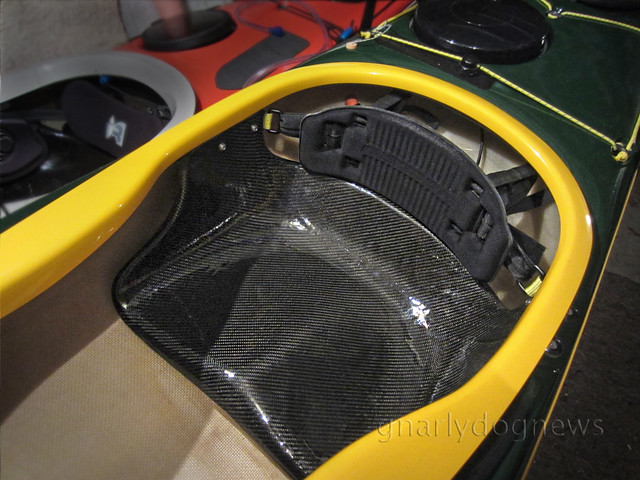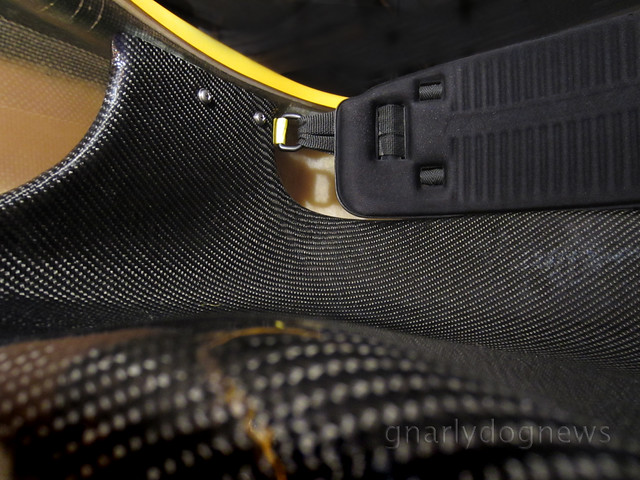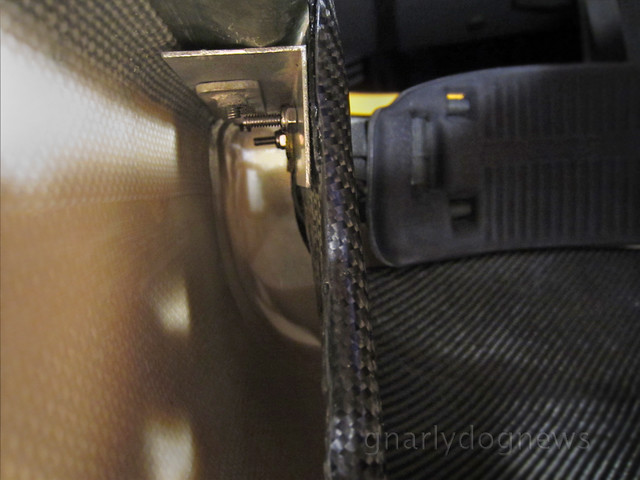Seats in kayaks seem to be often a deal breaker: some folk won't buy a kayak if the seat is not comfortable for them. Some kayak seats seem to fit more paddlers than others but there are also some seats that cause a lot of grief and paddlers go to great lengths to fix them.
The most common complaint I hear and read about from sea kayakers is the dreaded dead leg syndrome; after a while on the water (sometimes as brief as half an hour) some paddlers start to feel pins and needles or loose the feel of the legs altogether.
I am one of them: I find a lot of sea kayak seats not suitable for me. Maybe is my chunky thighs that force me to extend my legs lower to make them fit or something but I find most seats too short and too "peaked" (high up front) for my anatomy.
One seat that I have removed from more kayaks than any other one is the Valley plastic seat and the current model seems to be just as aggravating as the previous one.
In Adventuretess' Nordkapp LV I removed the seat and replaced it with a DIY fibreglass one removing the back band and replacing it with a foam block.
Steavatron recently borrowed Adventuretess's Nordkapp LV (Sialuk) and was amazed by the difference in feel and stability of the kayak.
Within half an hour of paddling Sialuk, he politely asked me if a similar seat was possible to be had in his own Nordkapp LV.
I agreed that with his help we could fabricate one for this kayak too, and we might as well go "bling".

The plastic VCP seat is easy to remove: 4 bolts on the outside of the coaming hold the seat in place.
Once the fsteners were removed the seat came right out but revealed a little problem; the edge of the seat has been "shaving" the hull and a few layers of fibreglass have already been carved away by the motion of the seat slightly swinging when paddling. If not caught in time it would have holed the kayak from the inside out (the same problem occurred in Sialuk).
Patching that divot was dead easy and we restored the hull to full strength.

The new seat is made from a laminate of glass fibre, double bias carbon under the sitting area and a veneer of the oh-so-sexy twill carbon fibre on top, for looks of course :-)
The edges of the seat have been reinforced with Kevlar to prevent the typical cracking that I have experienced in other factory chopped-mat kayak seats.

The new seat does not hang on its own but I used "L" brackets to support it. The original VCP hardware was re-utilized and new stainless steel bolts are anchoring the carbon seat to the bracket.

Stevatron was happy to reuse the original back band and hip pads. The back bands sling is attached to the seat with a short piece of webbing and a "D" ring. Existing straps firmly secure the back band to the rear bulkhead to prevent dislodgment when entering the cockpit.
After the maiden voyage Stevatron was happy with the position and height of the new seat and it was then finally secured to his kayak with a few dobs of polyurethane (Sikaflex) sealant to prevent any swinging and deliver a solid feel. In the event the seat would have to be removed for any reason a spatula will be inserted under the seat to break away those few spots of sealant.
Stevatorn finds the new seat a vast improvement on the stock VCP plastic one. The centre of gravity has been lowered and he finds that the Nordkapp LV has changed personality.
He is more confident on putting his kayak on edge and has gained stabilty when in textured waters.
Since the change and after a few paddles of several hours he no longer experiences the dead legs.
.



Wonderful job, looks great!!! One suggestion I have to prevent 'dead legs' is to put a thin mat (closed cell) under the legs - from feet to seat. It is soft and also great for colder days!
ReplyDeleteI lowered the seat in my Nordkapp after the first weekend.
ReplyDeleteIt was tight to fit my thighs under the sides, I actually had to squeeze them under and a half hour rolling session left me with big bruises 1/3 down my thighs because thats where the pressure was. My thighs aren't even big, 58cm midway.
It was also cutting into the bottom of my legs and restricting circulation, not too bad in my case but not perfect comfort.
The fix was easy, 15mm of plastic spacer each side, $5 worth of 4 longer bots and nuts. Didnt reuse the stock screw plate things, Bunnings didnt have the right sort of bolt thread. Cut away some of the foam spacer underneath but left it so it needs some force to compress which lowers movement and takes weight off the mounting points.
Plus I also glued some foam to the hull under the seat, so that any rubbing occurs between foam/foam, not foam/hull. Get a little sand between the foam and the hull and you have an abrasive sanding block, so even foam is damaging, if it can move it will grind away.
I also took the foam pad off the seat, with the idea that it will help reduce friction for rotation, dont know if it makes any difference to my technique. Drilled a few holes too so that the puddle of water drains out.
That fixed it right up. Room for my thighs and contact points and now further down.
Pressure under legs gone, though would still like the edge a little lower so I cant feel the edge lip at all.
Improves stability slightly.
I find it a very comfortable seat now and have no plans to modify it any further.
Joel, I am glad that your solution to an uncomfortable seat was simpler than the one I did to Stevatron, Adventuretess and my kayaks.
DeleteThe stock contoured top foam padding was removed even before my kayak's maiden voyage, and lowering the seat by removing foam underneath and adding a spacer at the fasters on the coaming is now standard procedure for all the kayakers that I paddle with and have a Valley boat.
Fabricating the new seat was for me essential to allow me to paddle any longer than an hour. Stevatron had similar problems while Adventuretess could tolerate the stock VCP a bit longer but finds the new fibreglass seat a vast improvement.
Of course, we are all different and have a different arse/legs; there is no such thing as a perfect seat that fits us all.
Hi Gnarly,
ReplyDeleteplease tell me the manufacturer of the hip-pads, shown on the 4th pic.
Thx a lot,
Tobi
those hip pads are the stock ones that came with the Valley plastic seat, reused here with the carbon seat.
DeleteI am unaware if Valley would sell those individually.
Thank you. I`m now trying to get my p&h seat out of my cetus, to tilt it a bit more forward. I unbolted all 4 screws and can now move the seat freely in the cockpit. But there's no way to get the seat out of the boat, cause it's to tight to turn the seat. Do you have any advice for me, how to get the seat out of the boat?
DeleteGS, I am not familiar with the P&H Cetus seat.
DeleteTo remove seats from my kayaks I have to twist and squeeze the pan to then wiggle it out. Usually the widest/highest spot of the deck with most room is forward, around the thigh brace area. I slide the seat there then twist and wiggle it and maybe squeeze it a bit too and with a bit of scraping I can get it out. In an Impex kayak the procedure is much simpler, in my Seabird Northsea it was really tricky to install the replacement seat I made while in the Zegul (from memory) was easy.
Gee, I've been complaining about Valley seats since 2010. But had no idea the bad design could be shaving the hull! I'm wondering if you've flagged this to Valley? They should respond. That's a serious problem. I'd never consider a Valley boat now.
ReplyDeleteAnother excellent article. Thanks so much for sharing this information. I've added a link to this article to my post about the Valley Avocet when I tested it in 2010. I couldn't stand the seat. Even in 2012, it's still one of my most popular posts. People should know about issues with Valley seats. So hopefully more people will find your article about the seats.
Cheers from Canada.
unfortunately the problem is not isolated to Valley seats since I had other brands eat away under at the hull (from inside) where grit and sand grind away with the swing of the seat. Tahe has solved the problem with a stud anchor in the front of their seat but that prevents moving the seat forward, if needed. Adding some stiff foam under the seat helps but that eventually gets eaten away too. Of course some paddlers never experience this since their paddling environment doesn't include sandy shores or their boat does not see a lot of sea miles. To avoid problems I bond my seats to the hull (small section, with polyurethane).
DeleteIts hard to have an adjustable seat which wont have any movement points.
DeleteTo prevent movement you have to use glue, and if they do that from the factory people will be upset about having to mess around scraping it off before they can play with different positions.
It is an easy bit of post-delivery work to find your ideal seat position then apply a bit of glue (sikaflex) to lock it in place.
If anything the manufacturers just need to mention that in an instruction manual or during delivery.
It's hard but not impossible. I like Tahe's approach: anchor stud in the centre.
DeleteHow about moving that anchor stud a bit further forward and design a seat that has a slotted hole for adjustment?
If other items can be have a slot adjustment I think a seat could have it too.
Of course that slot could be long as needed, or simple multiple holes.
Just thinking...
Gnarly have you considered the raider X design...its not adjustable of course but for those like me who don't use a backband, its as stable a link to the cockpit as you could get plus you don't have that hard to empty water behind the seat.
ReplyDeleteMark S
Mark, a few years back I owned a Raider (Ocean) and it didn't fit me that well.
DeleteThe cockpit was too wide (the coaming would not engage my thighs) and the deck just a bit too low for my feet (size 12).
The seat was a mixed feeling: easy to empty when swamped (lifting the bow) and no backbands to get caught on when entrying the cockpit.
I didn't like not having a solid backband to prevent me sliding back when actively pumping my legs (like sprinting in the surf).
And then there was that rudder... I just could not make friends with that piece of metal.
this seat is a masterpiece. I have struggled with kayak seats for years now.... your design is similar to what I have now in my romany - except mine is foam.... could you send out more details in your design and dimensions.
ReplyDeleteAnonymous, contact me at gnarlydognews@gmail.com and I can give you more details.
DeleteAgreed on the VCP seat & backband. I put a foam seat in my Nordkapp H2O. Can't say the foot pegs are much better. Great hull tho :-)
ReplyDelete